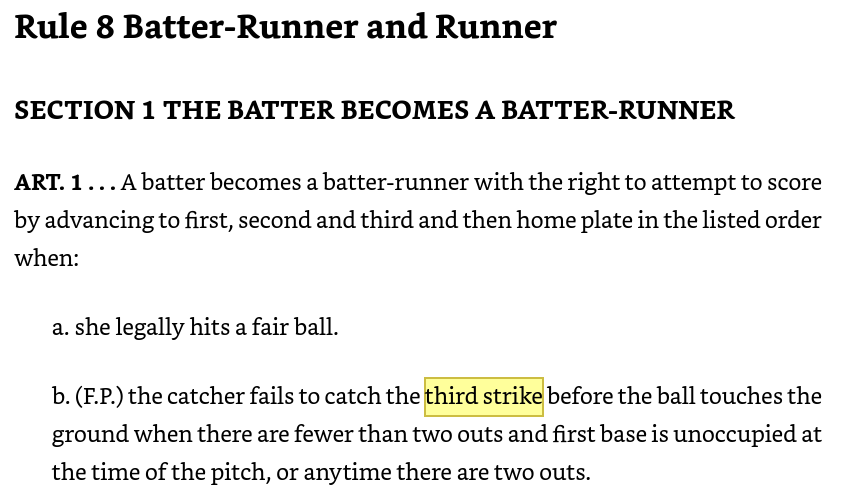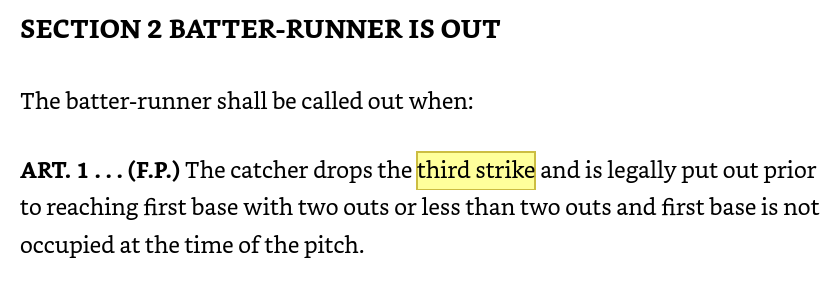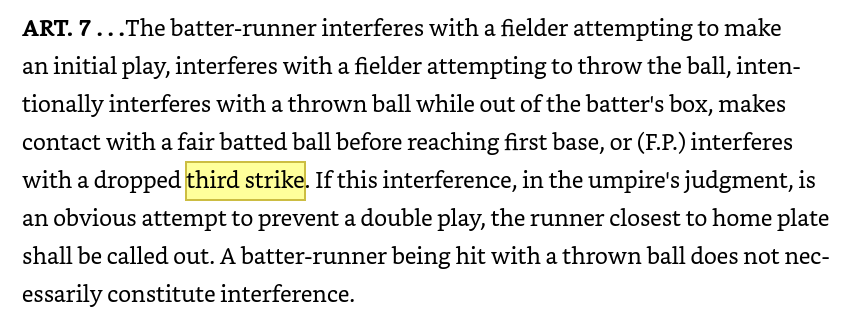- May 29, 2015
- 3,816
- 113
8-6-16(c)

The error in the writing is the unclear pronoun "This." Is "This" the rule or the sentence before it?
If "This" is the rule itself, then we cannot use this rule for a UK3.
If "This" is the sentence before it, it takes the word "may" out of play and tells us there is a ruling we MUST make. It doesn't say what that ruling is though: the runner must be considered interfering OR the runner must not be considered as interfering?
Either way, it does NOT say that a retired runner has carte blanche to run wild. It does say that the act itself is not necessarily interference. You must consider the context and what happens. A runner running on good faith should not be considered interference. A runner continuing to run when they should know they are out (umpire calls it loudly, play was evident, etc.) may be interfering.
So what else can we fall back on?
7-4-7

and 8-1(b)

and
8-2-1

and
8-2-7

A batter is typically given the benefit of doubt in their knowledge of whether the catcher caught the ball or not*. That happens behind them, so this is why batters are given some leeway to run on an uncaught third strike. However, a batter should know if first base is occupied with less than two outs. Regardless of whether the catcher catches the ball or not, the batter should know they are out due to the situation. This is the same situational awareness at the time of the pitch (not an evolving play) that is the standard we apply to the defense on an infield fly. This rule does NOT say it is definitively NOT interference if a batter runs.
*That's not a rule though. So what else do we have?
In the actual rulebook, just the definition of interference:

I'll have to dig into the casebook references tomorrow, as I don't have a digital one to cite efficiently.

The error in the writing is the unclear pronoun "This." Is "This" the rule or the sentence before it?
If "This" is the rule itself, then we cannot use this rule for a UK3.
If "This" is the sentence before it, it takes the word "may" out of play and tells us there is a ruling we MUST make. It doesn't say what that ruling is though: the runner must be considered interfering OR the runner must not be considered as interfering?
Either way, it does NOT say that a retired runner has carte blanche to run wild. It does say that the act itself is not necessarily interference. You must consider the context and what happens. A runner running on good faith should not be considered interference. A runner continuing to run when they should know they are out (umpire calls it loudly, play was evident, etc.) may be interfering.
So what else can we fall back on?
7-4-7

and 8-1(b)

and
8-2-1

and
8-2-7

A batter is typically given the benefit of doubt in their knowledge of whether the catcher caught the ball or not*. That happens behind them, so this is why batters are given some leeway to run on an uncaught third strike. However, a batter should know if first base is occupied with less than two outs. Regardless of whether the catcher catches the ball or not, the batter should know they are out due to the situation. This is the same situational awareness at the time of the pitch (not an evolving play) that is the standard we apply to the defense on an infield fly. This rule does NOT say it is definitively NOT interference if a batter runs.
*That's not a rule though. So what else do we have?
In the actual rulebook, just the definition of interference:

I'll have to dig into the casebook references tomorrow, as I don't have a digital one to cite efficiently.




